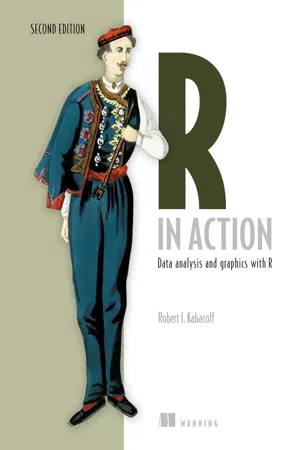
- 608 pages
- English
- ePUB (mobile friendly)
- Available on iOS & Android
About this book
Summary R in Action, Second Edition presents both the R language and the examples that make it so useful for business developers. Focusing on practical solutions, the book offers a crash course in statistics and covers elegant methods for dealing with messy and incomplete data that are difficult to analyze using traditional methods. You'll also master R's extensive graphical capabilities for exploring and presenting data visually. And this expanded second edition includes new chapters on time series analysis, cluster analysis, and classification methodologies, including decision trees, random forests, and support vector machines.Purchase of the print book includes a free eBook in PDF, Kindle, and ePub formats from Manning Publications. About the Technology Business pros and researchers thrive on data, and R speaks the language of data analysis. R is a powerful programming language for statistical computing. Unlike general-purpose tools, R provides thousands of modules for solving just about any data-crunching or presentation challenge you're likely to face. R runs on all important platforms and is used by thousands of major corporations and institutions worldwide. About the Book R in Action, Second Edition teaches you how to use the R language by presenting examples relevant to scientific, technical, and business developers. Focusing on practical solutions, the book offers a crash course in statistics, including elegant methods for dealing with messy and incomplete data. You'll also master R's extensive graphical capabilities for exploring and presenting data visually. And this expanded second edition includes new chapters on forecasting, data mining, and dynamic report writing. What's Inside
- Complete R language tutorial
- Using R to manage, analyze, and visualize data
- Techniques for debugging programs and creating packages
- OOP in R
- Over 160 graphs
About the Author Dr. Rob Kabacoff is a seasoned researcher and teacher who specializes in data analysis. He also maintains the popular Quick-R website at statmethods.net. Table of Contents
PART 1 GETTING STARTED
- Introduction to R
- Creating a dataset
- Getting started with graphs
- Basic data management
- Advanced data management
- PART 2 BASIC METHODS
- Basic graphs
- Basic statistics
- PART 3 INTERMEDIATE METHODS
- Regression
- Analysis of variance
- Power analysis
- Intermediate graphs
- Resampling statistics and bootstrapping
- PART 4 ADVANCED METHODS
- Generalized linear models
- Principal components and factor analysis
- Time series
- Cluster analysis
- Classification
- Advanced methods for missing data
- PART 5 EXPANDING YOUR SKILLS
- Advanced graphics with ggplot2
- Advanced programming
- Creating a package
- Creating dynamic reports
- Advanced graphics with the lattice package available online only from manning.com/kabacoff2
Frequently asked questions
- Essential is ideal for learners and professionals who enjoy exploring a wide range of subjects. Access the Essential Library with 800,000+ trusted titles and best-sellers across business, personal growth, and the humanities. Includes unlimited reading time and Standard Read Aloud voice.
- Complete: Perfect for advanced learners and researchers needing full, unrestricted access. Unlock 1.4M+ books across hundreds of subjects, including academic and specialized titles. The Complete Plan also includes advanced features like Premium Read Aloud and Research Assistant.
Please note we cannot support devices running on iOS 13 and Android 7 or earlier. Learn more about using the app.
Information
Table of contents
- Copyright
- Brief Table of Contents
- Table of Contents
- Praise for the First Edition
- Preface
- Acknowledgments
- About this Book
- About the Cover Illustration
- Part 1. Getting started
- Part 2. Basic methods
- Part 3. Intermediate methods
- Part 4. Advanced methods
- Part 5. Expanding your skills
- Afterword Into the rabbit hole
- Appendix A. Graphical user interfaces
- Appendix B. Customizing the startup environment
- Appendix C. Exporting data from R
- Appendix D. Matrix algebra in R
- Appendix E. Packages used in this book
- Appendix F. Working with large datasets
- Appendix G. Updating an R installation
- References
- Bonus Chapter 23. Advanced graphics with the lattice package
- Index
- List of Figures
- List of Tables
- List of Listings